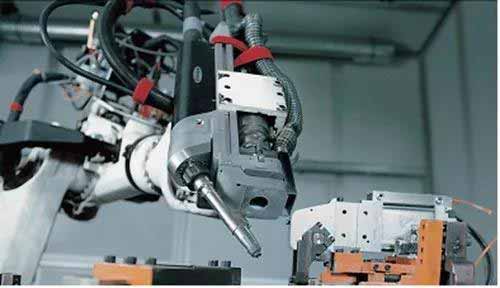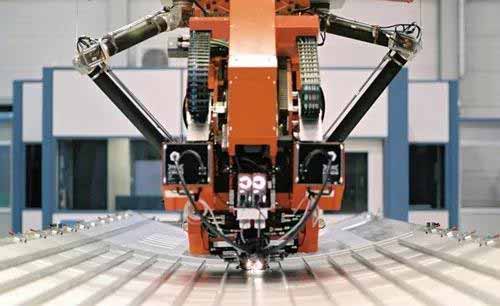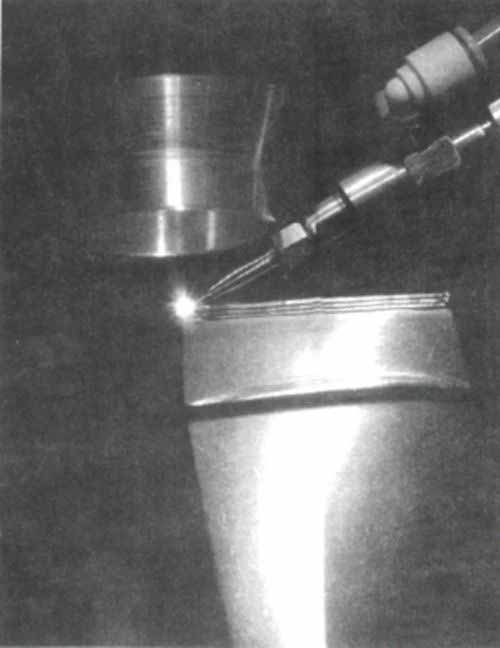Application of laser welding technology in aerospace manufacturing.(HY-industry technical centre)
With long-life, high-reliability, low-cost, high-performance design and manufacturing requirements, more and more new high-performance materials and complex structures are widely used in aircraft and aeroengine design, such as integral siding and integral leaves. Disc/leaf rings, hollow blades, single crystal/directional solidified blades, powder alloys and composite components. The expansion of new high-performance materials and complex structures has raised the requirements for aerospace manufacturing and repair technologies, including welding technology, while improving equipment performance.
 Laser welding has the advantages of high energy density, low heat input, small structural deformation, no vacuum environment, high quality, high precision, high efficiency, etc., and is the leader in all kinds of metal material fusion welding methods; combined with industrial robots, visual sensing Tracking system, automatic wire feeding (feeding powder) system, easy to achieve integration, automation, flexibility, mass production, occupying an increasingly high position in the global manufacturing industry. In recent years, with the continuous development of high-power lasers and the continuous improvement of the quality of laser beam, laser welding technology has realized a fundamental transformation from conductive welding to deep-fusion welding, and its application range has been further expanded, which is of importance in aviation manufacturing and repair. It is also constantly improving.
Laser welding has the advantages of high energy density, low heat input, small structural deformation, no vacuum environment, high quality, high precision, high efficiency, etc., and is the leader in all kinds of metal material fusion welding methods; combined with industrial robots, visual sensing Tracking system, automatic wire feeding (feeding powder) system, easy to achieve integration, automation, flexibility, mass production, occupying an increasingly high position in the global manufacturing industry. In recent years, with the continuous development of high-power lasers and the continuous improvement of the quality of laser beam, laser welding technology has realized a fundamental transformation from conductive welding to deep-fusion welding, and its application range has been further expanded, which is of importance in aviation manufacturing and repair. It is also constantly improving.
1.Application of laser welding in aircraft manufacturing and repair
(1) Application of laser welding in aircraft manufacturing In the field of aircraft manufacturing, laser welding technology is mainly used for the splicing of aircraft large skin and the welding of skin and long raft. The laser beam is also used in the assembly of body accessories. Welding techniques, such as wing boxes for pelvic fins and flaps. In recent years, laser welding technology has also been used in the manufacture of thin-walled parts such as air intakes and bellows.
As early as the early 1970s, the United States had used 15kW CO2 lasers to standardize welding tests and evaluation processes for various materials and components in the aircraft industry. The Edison Welding Institute of the United States and the Naval Welding Center jointly conducted research on laser welding technology for aircraft equipment. Italy introduced 15kW CO2 lasers from the United States in the late 1970s. Subsequently, the European Union carried out research on laser welding applications for various containers and lightweight structures in aerospace engines. The materials involved in titanium alloys. Nickel-based, iron-based superalloys, etc. The British Welding Research Institute (TWI) successfully realized aluminum alloy reinforced wall plate double-beam YAG laser wire-filling welding with good welding quality and less than TIG welding. German Aerospace (MBB) uses laser welding for all connections of aircraft fuselage, wings and internal partitions and ribs, replacing the original riveting process and being called a major technology in the aerospace industry by the German aerospace industry. revolution.
Around 2002, Airbus used a two-beam double-sided synchronous laser welding process to weld the skin and purlins of the two lower-wall panels of the A318 aluminum alloy fuselage into an integral fuselage siding, reducing the aircraft. The weight of the fuselage is nearly 20%, and the strength is increased by nearly 20%. It is subsequently applied to the overall siding of the A380, A340, A350 and other models, as well as the bulkhead slabs of the A380 and the structure of the drone. The total length of the weld on the A350 is up to 1000m.
China’s laser welding technology research started in the 1980s. After years of efforts, it has successfully realized the application of tailor-welding and pipe welding in automobile manufacturing. With the increasing depth and breadth of the basic research of aluminum alloy and titanium alloy laser welding technology, laser welding applications of some aircraft components have been realized.
 Since the late 1990s, AVIC Beijing Aerospace Manufacturing Engineering Research Institute has carried out research on laser welding technology of aircraft components. In 2003, the company first applied laser welding technology to the welding of key components of aircraft titanium alloy siding, and simultaneously laser-filled wire welding, laser arc composite welding, laser double spot welding, T-joint laser double beam double-side synchronization. A lot of research has also been done on new processes such as welding technology. Around 2014, in the domestic large-scale passenger aircraft design, some aluminum-lithium alloy lower wall plates of the front fuselage and the middle and rear fuselage are planned to adopt laser welding scheme, and China Commercial Aircraft Co., Ltd. took the lead in carrying out process stability analysis and deformation control, and Related research work on defect detection and control, and preliminary realization of laser welding of test piece-level components.
Since the late 1990s, AVIC Beijing Aerospace Manufacturing Engineering Research Institute has carried out research on laser welding technology of aircraft components. In 2003, the company first applied laser welding technology to the welding of key components of aircraft titanium alloy siding, and simultaneously laser-filled wire welding, laser arc composite welding, laser double spot welding, T-joint laser double beam double-side synchronization. A lot of research has also been done on new processes such as welding technology. Around 2014, in the domestic large-scale passenger aircraft design, some aluminum-lithium alloy lower wall plates of the front fuselage and the middle and rear fuselage are planned to adopt laser welding scheme, and China Commercial Aircraft Co., Ltd. took the lead in carrying out process stability analysis and deformation control, and Related research work on defect detection and control, and preliminary realization of laser welding of test piece-level components.
(2) Application of laser welding in aircraft repair Laser welding technology has the characteristics of fast welding speed and simple riveting construction. It is an ideal technology to replace the riveting process and has great application advantages in the field of aircraft structural repair. Some researches have been carried out on laser welding technology for repairing aircraft components in China, and some components have been repaired and applied. An aircraft repair factory in China has applied laser welding technology to the damage repair of aircraft titanium alloy tailgates, and has developed a laser welding repair process specification for titanium alloy structures. Around 2012, the First Air Force Research Institute adopted a robotic flexible laser cutting/welding system to complete the application of cutting and welding integrated repair of the lower surface of the titanium alloy skin of a certain type of aircraft wing. The surface after repair was smooth and the structural performance was complete. Recovery, long-term reliable work, to meet the needs of use.
2. Application of laser welding in engine manufacturing and repair
(1) Application of laser welding in engine manufacturing Laser welding technology has unique advantages in the welding of thin-wall high-precision components of aero-engines due to its excellent heat source performance, excellent deformation control advantages and wide material welding adaptability. It has great development prospects in the welding of new materials such as aviation superalloys, titanium alloys, titanium-aluminum intermetallic compounds. Foreign countries attach great importance to the development and application of laser welding technology for aerospace components. The EU’s Sixth Framework Research Project AROSATEC has carried out laser welding technology research on compressor stator and cascade, high pressure and low pressure blade outlet and cover connection, and turbine casing.
 Pratt & Whitney USA completes automatic laser welding of components required for turbine blades, such as JT9D and FLO’s secondary turbine rotor blades and turbine blades, guide vanes, casings and combustion of V2500, F100-PW-220, PW2037, PW4000 and other engines. Room and so on. GE has also successfully completed laser welding of engine-guided vane assemblies, effectively solving the problems of laser welding deformation and cracking of nickel-base alloy parts, and welding jet engine combustor bushings with 6kW CO2 laser equipment. British R&R uses solid-state lasers and robots to automate the welding of titanium alloys and superalloys, ensuring consistency in the weld and welding process, reducing weld distortion, low joint residual stress, and greatly reducing the amount of calibration work. Japan JAEC related companies completed the front and rear welding of the fan casing of the V2500 engine using a 6kW CO2 laser device.
Pratt & Whitney USA completes automatic laser welding of components required for turbine blades, such as JT9D and FLO’s secondary turbine rotor blades and turbine blades, guide vanes, casings and combustion of V2500, F100-PW-220, PW2037, PW4000 and other engines. Room and so on. GE has also successfully completed laser welding of engine-guided vane assemblies, effectively solving the problems of laser welding deformation and cracking of nickel-base alloy parts, and welding jet engine combustor bushings with 6kW CO2 laser equipment. British R&R uses solid-state lasers and robots to automate the welding of titanium alloys and superalloys, ensuring consistency in the weld and welding process, reducing weld distortion, low joint residual stress, and greatly reducing the amount of calibration work. Japan JAEC related companies completed the front and rear welding of the fan casing of the V2500 engine using a 6kW CO2 laser device.
As early as the late 1990s, HY-Industry and the Northwestern Polytechnical University jointly researched the laser welding process of the front and rear cold air ducts of the Inconel 625 superalloy aircraft engine. The CO2 laser welding equipment was used to develop the cleaning from the pre-weld. A complete set of welding processes, from assembly welding to post-weld treatment, meets the needs of use. Beijing Aeronautical Manufacturing Engineering Research Institute has applied laser welding technology to the manufacture of engine titanium alloy bearing components, and adopted laser welding technology instead of plate diffusion bonding technology. It has pioneered the fabrication of multi-layer structure of titanium alloy superplastic forming/laser welding in China. handicraft Research. Boeing and Washington State University have also developed a combination of superplastic forming and laser welding. Laser welding can be used to more flexibly construct core patterns, greatly increasing production efficiency and reducing costs.
2) Application of laser welding in engine repair The main damage forms of engine components include foreign object damage, wear, cracks, ablation and processing defects, and the diversity of component materials, damage parts and damage forms, which determine the repair after damage. The complexity. Laser welding repair technology facilitates near net shape formation, reduces crack generation, and is widely used in aero engine parts repair.
Honeywell has successfully applied laser welding to the blade repair of the Avro RJ regional jet engine LF507. The Liburdi Group of Canada uses automatic wire feeding laser welding equipment for blade repair. The RB211 engine has been repaired with high, medium and low pressure turbine blades (see Figure 7). In 2001, it was authorized by R&R to specialize in RB211 engine blades and other components. Laser welding repair. MTU Germany has developed laser welding technology for blade damage repair of fan integral leaf discs, forming specifications for welding, machining, precision polishing and non-destructive testing.
Laser low-heat input precision metal deposition process is a patented technology of H&R. Similar to laser-filled wire welding, it mainly uses laser-melted metal flat wire to pile up layer by layer. The difference is that this technology does not need to be built on the repaired parts. Molten pool. The US Navy and Air Force have successfully applied this technology to damaged integral blade repairs, resulting in shorter repair times, improved accuracy, reduced cost, longer life, and proven on the T70 engine compressor stage 1 integral blade. On this basis, H&R completed the relevant high cycle fatigue test and evaluation for the Pratt & Whitney F135 engine repair, achieving the same level of repair as the T73 engine compressor overall blade.
China has carried out more research on laser additive repair technology, and has completed repair verification of various structural and material engine components, but there are relatively few applications in laser welding repair applications.
The Institute of Metals of the Chinese Academy of Sciences uses laser micro-welding for in-situ non-destructive repair. This technology has the advantages of minimum internal stress, best spatial interface, and minimal defect repair area. It has been successfully applied to a hollow guide vane developed in China. The repair of the casting process hole, as well as the repair of the looseness, shrinkage holes and cracks on the blade size mounting plate of the low-pressure turbine, the first-class and the second-level triple-conductor precision casting guide, passed the test of the installed bench.
 Shenyang Engine Design Research Institute and Shenyang Liming Company jointly carried out research on laser tip repair technology for blade tip crack of a certain type of engine high-pressure turbine. It passed the 300h thermal shock test and met the inspection standard of overhaul blade, which satisfied the use requirements. Shenyang Liming Aero Engine Co., Ltd. carried out research on laser welding repair process for engine main engine ignition wire deep repair demand, completed 6 test piece level repair verification, formed formal repair process, completed two ignition wire repair applications, and repaired after ignition The appearance of the wire and various electrical properties were all qualified and passed the test run. When repairing a certain type of engine intermediate machine, laser welding is applied to the cracks on the argon arc welding seam of the fixed annular shell and the support plate, and the weld bead is well formed, and the deformation before and after meets the requirements.
Shenyang Engine Design Research Institute and Shenyang Liming Company jointly carried out research on laser tip repair technology for blade tip crack of a certain type of engine high-pressure turbine. It passed the 300h thermal shock test and met the inspection standard of overhaul blade, which satisfied the use requirements. Shenyang Liming Aero Engine Co., Ltd. carried out research on laser welding repair process for engine main engine ignition wire deep repair demand, completed 6 test piece level repair verification, formed formal repair process, completed two ignition wire repair applications, and repaired after ignition The appearance of the wire and various electrical properties were all qualified and passed the test run. When repairing a certain type of engine intermediate machine, laser welding is applied to the cracks on the argon arc welding seam of the fixed annular shell and the support plate, and the weld bead is well formed, and the deformation before and after meets the requirements.
3.HY-Industry Technical Department’s suggestions on the business of laser welding
-
Accelerate the independent research and development of key welding equipment, learn from foreign advanced laser development experience, introduce, digest, absorb and re-innovate, accelerate high-power, high beam quality lasers suitable for aviation equipment products, as well as automatic wire feeding, visual tracking, online Independent research and development of supporting systems such as testing.
-
Increasing the research depth of laser welding to establish a stable cooperative research and development relationship between schools and institutes, and to increase the depth of basic research of laser welding technology, such as pores, cracks, etc. Joint surface integrity and reliability evaluation, etc., develop welding materials suitable for repairing harsh environmental service requirements such as high temperature and complex stress, and meet the high-quality, high-precision welding repair requirements of process supporting technology and pre-repair processing technology.
-
Emphasis on the development of welding technology for new materials. Actively develop laser welding processes for high-strength high-temperature titanium alloys, new high-temperature alloys, titanium-aluminum intermetallic compounds, single crystal/directional/powder superalloys, etc., to form weldability of covered materials. Process data of process, joint structure and performance, and establish the corresponding laser welding process.
-
Accelerate the application of new welding technology research on the characteristics of aerospace products and design structures, and accelerate the application of new laser welding methods for aerospace manufacturing and repair needs, such as laser wire filler automatic welding, long focal length laser welding, laser hybrid welding and Double beam (filled wire) welding, etc.
-
Widening the application of laser welding technology to learn from the successful experience of foreign aviation manufacturing, establish an integrated research and development model of design-material-manufacturing, and promote the engineering application of laser welding on typical components of aviation aircraft and engines, such as aircraft siding , ventral fins and flaps, etc., various thin-walled casings, combustion chamber components, blades and other complex and precision components of the engine, as well as simple welded structural parts such as afterburning cylinders and diffusers.
-
Establish a sound process quality standard system Combining new materials, new structures, new methods and new product development and application progress, gradually establish and improve China’s laser welding process and quality standard system, and establish and continuously improve the welding process database.
-
(7) Accelerate the automation and intelligent process combined with industrial robot system, automatic wire feeding system, visual sensor tracking system, online inspection, evaluation and real-time control system for welding quality, boosting aviation product automation and intelligent manufacturing, and improving laser welding Process adaptive control capability and production efficiency.

